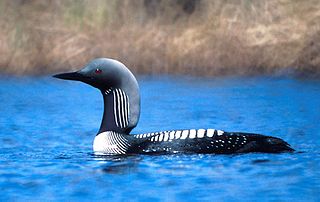Inuvialuktun, also known as Western Canadian Inuit, Western Canadian Inuktitut, and Western Canadian Inuktun, comprises several Inuit language varieties spoken in the northern Northwest Territories and Nunavut by those Canadian Inuit who call themselves Inuvialuit.

Kitikmeot Region is an administrative region of Nunavut, Canada. It consists of the southern and eastern parts of Victoria Island with the adjacent part of the mainland as far as the Boothia Peninsula, together with King William Island and the southern portion of Prince of Wales Island. The regional seat is Cambridge Bay.

Cambridge Bay is a hamlet located on Victoria Island in the Kitikmeot Region of Nunavut, Canada. It is named for Prince Adolphus, Duke of Cambridge, while the traditional Inuinnaqtun name for the area is Ikaluktuutiak or Iqaluktuttiaq meaning "good fishing place".
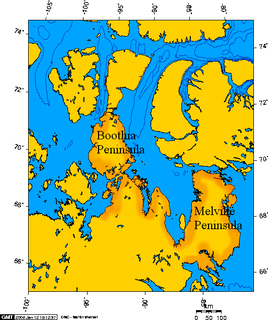
Boothia Peninsula is a large peninsula in Nunavut's northern Canadian Arctic, south of Somerset Island. The northern part, Murchison Promontory, is the northernmost point of mainland Canada.
Kangiryuarmiutun, is a dialect of Inuit language spoken in Ulukhaktok, Northwest Territories, Canada by the Kangiryuarmiut, a Copper Inuit people. The dialect is part of the Inuvialuktun language. The people of Ulukhaktok prefer to think of it as Inuinnaqtun and it is essentially the same.

Ulukhaktok is a small hamlet on the west coast of Victoria Island, in the Inuvik Region of the Northwest Territories, Canada.

Kugaaruk, formerly known as Pelly Bay until 3 December 1999, is located on the shore of Pelly Bay, just off the Gulf of Boothia, Simpson Peninsula, Kitikmeot, in Canada's Nunavut territory. Access is by air by the Kugaaruk Airport and by annual supply sealift. Kugaaruk means "little stream", the traditional name of the brook that flows through the hamlet.
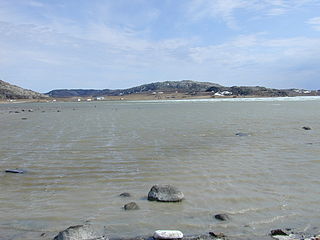
Umingmaktok is a now abandoned settlement located in Bathurst Inlet in the Kitikmeot Region of the Canadian territory of Nunavut. The community was previously known as Bay Chimo and the Inuit refer to the community as Umingmaktuuq.

Bathurst Inlet,, is a small Inuit community located in Bathurst Inlet in the Kitikmeot Region of Nunavut, Canada. As of the 2016 census the population remained at zero.
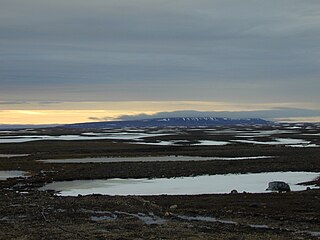
Ovayok Territorial Park is a park situated 15 km (9.3 mi) east of Cambridge Bay, Kitikmeot, Nunavut, Canada. The park is relatively small and covers an area of approximately 16 km2 (6.2 sq mi). The park can be accessed by vehicle from the community as a gravel road runs directly to it.
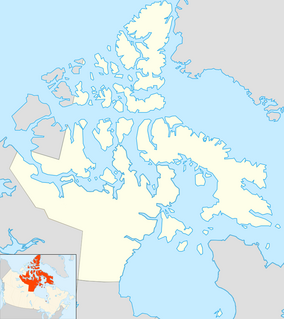
Adelaide Peninsula (Iluilik), ancestral home to the Illuilirmiut Inuit, is a large peninsula in Nunavut, Canada. It is located at 68°06′N097°48′W south of King William Island. Its namesake is Queen Adelaide, consort of King William IV of the United Kingdom.

Kugluk/Bloody Falls Territorial Park is located about 15 kilometres (9.3 mi) southwest of Kugluktuk, Nunavut, Canada. The 10 hectares park is situated around the Bloody Falls on the Coppermine River and was listed as a national historic site in 1978.

Ferguson Lake is located on southern Victoria Island in the Kitikmeot Region of Nunavut, in northern Canada. It drains westward into Iqaluktuuq River which is a segment of the Ekalluk River, 5 mi (8.0 km) from the northeastern side of Wellington Bay (Ekaloktok), on Dease Strait, Arctic Ocean Ferguson Lake is the namesake of Constable Ferguson, a Royal Canadian Mounted Police member.

Copper Inuit are a Canadian Inuit group who live north of the tree line, in what is now Nunavut's Kitikmeot Region and the Northwest Territories's Inuvik Region. Most historically lived in the area around Coronation Gulf, on Victoria Island, and southern Banks Island.
Denmark Bay is an Arctic waterway in Kitikmeot Region, Nunavut, Canada. It is located in western M'Clintock Channel, off the eastern coast of Victoria Island. It is separated from Homan Bay by a peninsula with a narrow isthmus.
Ekalluktogmiut were a geographically defined Copper Inuit subgroup in Canada's Nunavut territory. They were located along the Ekalluk River near the center of Victoria Island, Albert Edward Bay in western Victoria Strait, and Denmark Bay. According to the Arctic explorer Vilhjalmur Stefansson, the Ekalluktogmiut winter hunt on Dease Strait.

The Umingmuktogmiut are a geographically defined Copper Inuit band in the northern Canadian territory of Nunavut, Kitikmeot Region. They were located on the western coast of Kent Peninsula, and also further south in eastern Bathurst Inlet around Everitt Point by the Barry Islands. Umingmuktogmiut were notable amongst other Copper Inuit as they had a permanent community, Umingmuktog. They could hunt and fish for Arctic char, Arctic fox, barren-ground caribou, fur seals, and muskox prevalent in the area.
The Ekalluk River is a river in Kitikmeot Region, Nunavut, Canada. It is located in central through southeastern Victoria Island. Its source is Ferguson Lake, and it flows west to Wellington Bay and east to Albert Edward Bay. Nearby lakes include Keyhole Lake, Kitiga Lake, and Surrey Lake. The closest community is Cambridge Bay.





